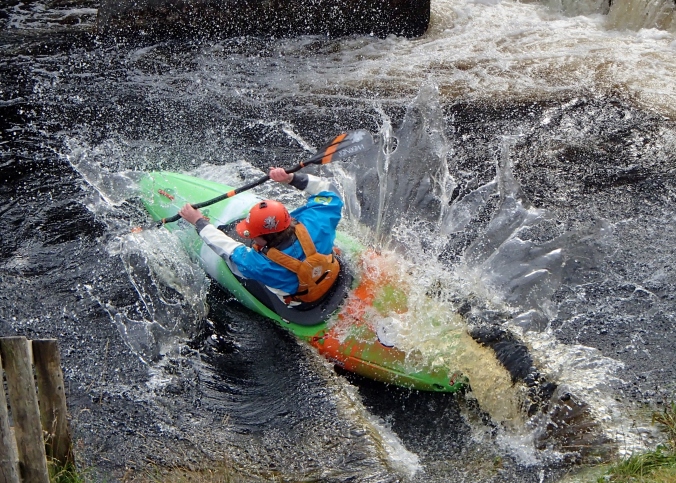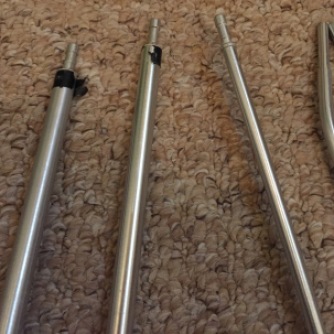Until recently, I’ve never carried a repair kit whilst on the river, under the assumption that if I broke any of my equipment I’d either just deal with it or get off the river.
As Chris Brain pointed out to me on a 4* White Water Leader Assessment though, it isn’t always that simple; the toolbox in your car might be incredibly comprehensive, but it’s no use when you’re miles away in a remote gorge with a loose seat and 6km of grade IV to negotiate before the nearest egress.

Left to Right, Top to Bottom: Paracord, Butane Welding Pen, Tenacious Tape, Dental Floss + Needle, Footrest Nuts, Miscellaneous Bolts & Nuts, Waterproof Repair Patches, Pocket Tool, Cable Ties, Permanent Marker, Zip Lube, Waterproof Glue, Spare Bung, Duct Tape, Container, Security Torx Bit, Plumber’s Mait, Plastic Welding Rods, Nylon Nuts, Sandpaper + Stanley Knife Blade.
So, I got to putting together a kit to fix the most common issues whilst kayaking, and here’s what it consists of (I won’t go into too much detail with every item, as most have several, fairly obvious and straightforward uses that would take forever to list, but I will pick out some key pieces and give a little more info on them):
A Durable, Water Resistant Container
I’m generally quite picky with my gear choices, and as soon as I started thinking about putting my repair kit together I had a very clear picture of what sort of container I wanted to use – unfortunately, I had no idea if it actually existed!
What I was looking for was a flexible, transparent, pouch style semi-dry container so I could stuff plenty of bits inside without it taking up too much room in my Ocoee Bag. Initially I was looking at pencil cases and document pouches, but nothing I found had a zip that looked like it’d stand up to any abuse – then I walked in to Tamarack Outdoors and saw the perfect solution, the Exped A6 Sized Vista Organiser.
Duct Tape, Paracord and Cable Ties
Plastic Welding Kit
A boat split is probably one of the worst kit breakages you could have on the river, so it’s worth having something with you to repair it; a plastic weld is the neatest and strongest way to do this.
Some people will just carry a lighter and a teaspoon or similar item to smooth the surrounding plastic over the split, but as usual I’ve gone the whole hog and got an Antex Gascat 60 Butane Torch Kit and some Plastic Welding Rods. I chose the Gascat as the lighter is handily built into the lid, and it’s necessary to buy the kit so you get the flame attachment (I don’t carry the other bits with me). I also have some Sandpaper and a Stanley Knife Blade to neaten up the split before and after a weld.
Pocket Tool
The Leatherman Piranha 2 is very compact, and has a screwdriver and various spanner sizes to suit most brands of kayak. I swapped out the additional screwdriver bits for Allen Key ones, and I also carry a Security Torx bit, as these fit the best kayaks in the world (Pyranha, of course!).
Spare Bung and Footrest Nuts, plus Miscellaneous Bolts & Bits
Plumber’s Mait
This stuff is fantastic for quick repairs of boat splits, or for awkward cracks that can’t be welded easily; it’s a putty-like material which is available from most DIY stores and will set solid, even when wet!
Some people will also carry a strip of flash bang for quick split repairs, but this is very difficult to remove afterwards and I’ve decided that I have enough repair options with the plumber’s mait and plastic welding kit.
Items for Quick Dry Gear Fixes
No one wants to paddle for a long period with a leak in their cag, and it could even be quite dangerous if the rip is big enough to cause any of your kit to fill with water; McNett make Tenacious Tape™ and Patches that can be used to do bombproof repairs on small holes or seams and bigger tears.
Drysuit Zip Lube
Spraydeck Repair Gear
A ripped spraydeck can mean anything from distracting drips on your legs to having to stop and empty your boat every couple of hundred metres, but sewing it back up with cotton thread will only last for a short time before the cotton deteriorates and breaks; instead, it’s best to sew a deck using dental floss and a strong sewing needle, then seal the repair with Waterproof Glue.
I’ve still never had to use any of the above (touch wood), but I now feel more confident knowing they’re always on the river with me.
What’s in your repair kit?
53.677019
-2.456732








